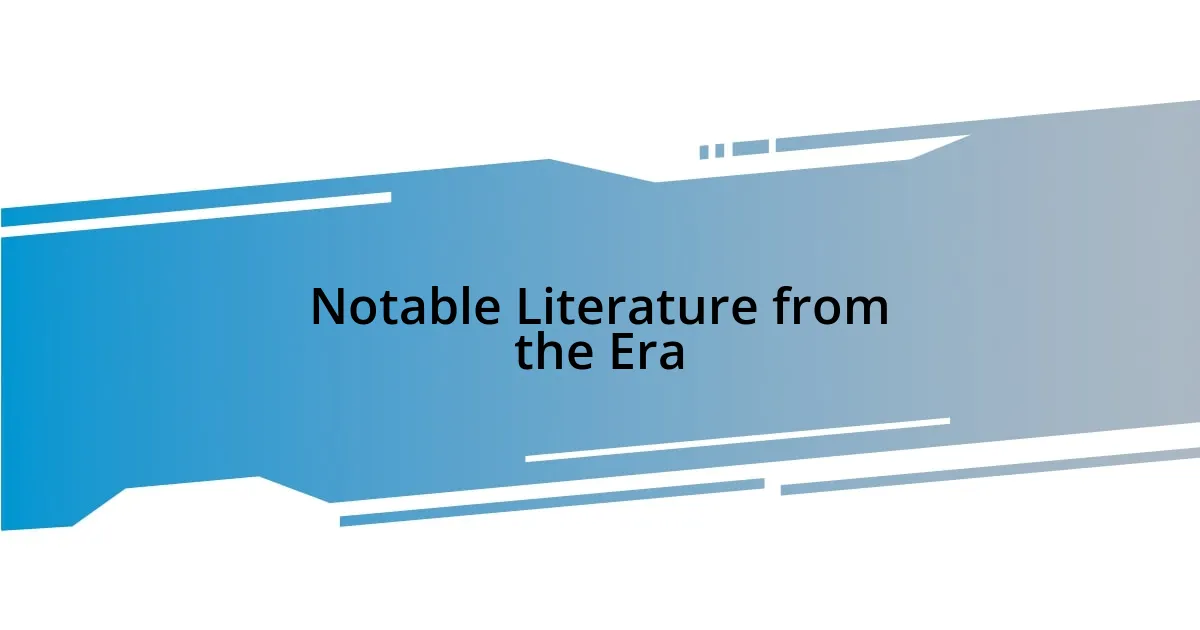Key takeaways:
- The Victorian Era (1837-1901) was marked by technological advancements and cultural richness, contrasting the grandeur of the British Empire with the grim realities of industrialization and urban poverty.
- Daily life varied significantly by social class, with the working class enduring harsh factory conditions, while the middle and upper classes enjoyed leisurely lifestyles, highlighting issues of social responsibility.
- Victorian literature, exemplified by works from Charles Dickens and the Brontë sisters, explores deep themes of identity, sacrifice, and emotion, resonating with modern societal struggles.
- The era’s literature serves as a bridge between past and present, encapsulating timeless questions about individuality and human experience.

Overview of the Victorian Era
The Victorian Era, spanning from 1837 to 1901, was a time of remarkable transformation in Britain, both socially and culturally. Imagine living in a world where steam-powered machines dominated daily life and literature flourished like never before. I often ponder how the innovations of this period shaped our modern society; what would we have done without the railways or the telegraph?
As I delve into the era, I can’t help but feel a sense of awe at its contrasts. On one hand, there was the grandeur of the British Empire, spreading its wings across the globe; on the other, a stark contrast with the grim realities of industrialization and urban poverty. When I read about the struggles of factory workers, I feel a deep empathy. How could such progress occur alongside such suffering?
Culturally, Victorian society was vibrant, with artists and writers pushing boundaries. The works of Charles Dickens or the Pre-Raphaelite Brotherhood resonate with me. They offered glimpses into the complexities of human nature and society. Isn’t it fascinating how their insights still hold relevance today? Engaging with their stories makes me reflect on how art and literature anchor us in our time.

Daily Life in Victorian Society
In Victorian society, daily life was a tapestry woven from both the bright and dark threads of existence. For instance, the working class often faced grueling hours in factories, where the air was thick with the smell of coal and machinery. I remember reading a diary entry from a silk worker; it struck me how, even amid despair, she found little moments of joy, like sharing lunch with her friends.
Meanwhile, the middle and upper classes enjoyed a vastly different lifestyle, marked by leisure and refinement. They gathered for tea and participated in social clubs, discussing art, literature, and the latest fashions. This contrast always makes me curious—how did they remain so oblivious to the struggles of their poorer neighbors? Engaging with this question highlights the complexities of social responsibility during the era.
The family unit played a central role in daily life, often dictated by strict gender roles. Women were generally expected to tend to the home and raise children while men brought home the bread. Reflecting on this dynamic, I often think about how these roles not only preserved traditions but also stifled individual desires. How many unfulfilled dreams were cast aside in the name of duty?
| Social Class | Daily Life Experience |
|---|---|
| Working Class | Grueling factory work, long hours, and scant pay; community gatherings were often a source of solace. |
| Middle Class | Leisurely afternoons filled with tea, social clubs, and artistic pursuits; a focus on education and self-improvement. |
| Upper Class | Extravagant parties and a strong social network; philanthropy was common, yet often performed from a distance. |

Notable Literature from the Era
The Victorian era produced some of literature’s most celebrated works, and each piece invites us to explore the intricacies of human experience. For example, Charles Dickens’ “A Tale of Two Cities” captivates me with its themes of sacrifice and redemption. How powerful is it that a story set against the backdrop of the French Revolution resonates so deeply with our modern struggles for justice and equality?
Moving on, I find myself captivated by the works of the Brontë sisters. Their novels, like “Jane Eyre,” delve into the complexity of identity and personal freedom. I remember sitting in a cozy corner of my favorite café, reading a passage where Jane asserts her independence. It struck me – how often do we feel the need to defend our individuality in the face of societal expectations? It’s a timeless question that continues to echo even today.
Then, of course, there’s the poetry of Alfred Lord Tennyson. His evocative verses often linger in my mind, particularly “In Memoriam,” which reflects on love and loss with such raw honesty. When I read his poignant exploration of grief, I can almost feel the weight of his words. Isn’t it fascinating how literature can encapsulate emotions so profoundly that they feel like our own? This is the magic of Victorian literature; it bridges the gap between past and present, making us feel connected to those who walked before us.
















